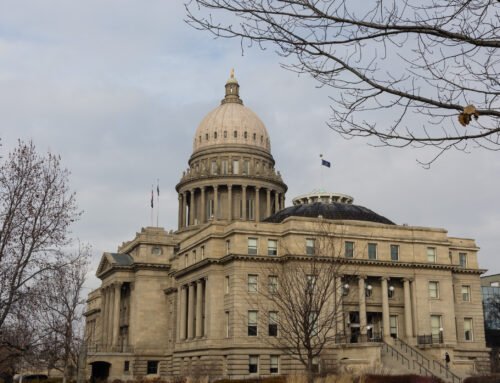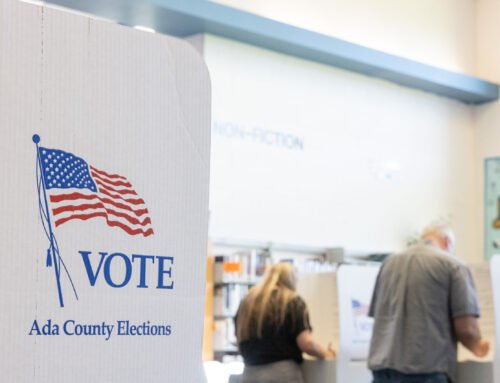Idaho has removed children from Medicaid faster than many other states.
The federal government wants that to change.
Earlier this year, states started to remove people from Medicaid after federal pandemic era-rules that kept people on Medicaid automatically expired. Millions of people have lost access to Medicaid since states started to review the eligibility of people on Medicaid — which is typically done routinely.
But most children who lost Medicaid or the Children’s Health Insurance Program live in nine states — including Idaho, the federal Department of Health and Human Services said in a news release on Monday.
HHS Secretary Xavier Becerra wrote in a letter to Idaho Gov. Brad Little on Monday that he was “deeply alarmed” that 56,580 fewer Idaho children were on CHIP or Medicaid as of the end of September, compared to when states started removing people from Medicaid this spring.
“HHS takes its oversight and monitoring role during the renewals process extremely seriously and will not hesitate to take action to ensure states’ compliance with federal Medicaid requirements,” Becerra wrote in his letter to Idaho.
The nine Republican-led states Becerrea sent letters to were Arkansas, Florida, Georgia, Montana, New Hampshire, Ohio, South Dakota and Texas. These states account for 60% of the decline in children’s Medicaid and CHIP enrollment nationally, the department said.
Need to get in touch?
Have a news tip?
Enrollment in Medicaid and CHIP has declined by 2.2 million children this year, the Centers for Medicaid and Medicare Services estimates.
“Because all children deserve to have access to comprehensive health coverage, I urge you to ensure that no child in your state who still meets eligibility criteria for Medicaid or CHIP loses their health coverage due to ‘red tape’ or other avoidable reasons as all states ‘unwind’ from the Medicaid continuous enrollment provision that was in place during much of the COVID-19 public health emergency,” Becerra wrote in his Idaho letter. “This is especially important for communities of color and underserved communities across the country — we know more than half of all children in Medicaid and CHIP are Hispanic, Black, Asian/Pacific Islander, or American Indian and Alaska Native.”
Idaho ties for highest child removal rate, federal data shows
The number of children enrolled in Idaho Medicaid or CHIP declined 27% between March and September, the federal data shows. That’s after Idaho and other states began resuming Medicaid application processes.
Idaho and South Dakota tied for the highest rates of decline in children’s coverage. Idaho ranked ninth for the actual number of children it removed from Medicaid and CHIP, according to the federal data.
In a statement, Idaho Department of Health and Welfare spokesperson AJ McWhorter said the agency followed federal law and that its plan to remove people from Medicaid was federally approved.
“Idaho cares about our families and particularly our children, but Medicaid state and federal eligibility requirements exist for good reason,” McWhorter said.
About 311,000 Idahoans are enrolled in Medicaid or CHIP in September, federal data released Monday show.
Idaho this year removed 121,000 people from Medicaid who state officials thought were likely ineligible, including 77,000 people removed for not providing the state information it had requested. At least 13,000 Idahoans removed for not responding have since re-enrolled in Idaho Medicaid, an Idaho official announced last month.
Idaho Department of Health and Welfare Division of Welfare Administrator Shane Leach defended Idaho’s approach to reviewing Medicaid eligibility in a blog post on Tuesday.
“We know that we’ve taken the appropriate steps over the last nine months to make sure qualifying children and adults get and maintain the health insurance coverage they need,” Leach wrote, saying that state officials twice paused the process.
Idaho previously restored coverage to 18,000 Idahoans on Medicaid, including 6,000 children, Leach said. He also said the Idaho Department of Health and Welfare’s data only shows 51,000 Idaho children lost Medicaid.
“Idaho followed the law, federal guidance, and our federally approved plan to complete our unwinding work,” Leach wrote. “Most other states are still in process, with some just beginning. As they complete their unwinding activities, it will be interesting to compare.”
Tens of thousands of Idahoans removed from Medicaid got private insurance, including many children, McWhorter said. Idaho’s health insurance marketplace, Your Health Idaho, reportedly converted 31% of people removed to insurance policies. That’s one of the highest Medicaid to insurance market conversion rates in the country, Your Health Idaho Executive Director Pat Kelly said in September. Your Health Idaho is working through final enrollment figures, but still reported a 31% conversion rate from Medicaid, spokesperson Nichol Lapierre told the Idaho Capital Sun on Tuesday.
The number of Idaho children removed from Medicaid wasn’t surprising, given that half of Idahoans on Medicaid are children, said Hillariie Hagen, senior policy associate at Idaho Voices for Children.
“For the last several years, too many legislators have been focused on slashing Medicaid budgets and reducing enrollment. If we don’t want to be ranked last in the country for covering children, we have to acknowledge the role Medicaid plays and the state’s responsibility of ensuring it’s sustainable and strong,” Hagen told the Idaho Capital Sun.
Idaho children are eligible for Medicaid at higher incomes than adults. American children removed from Medicaid could be getting other health coverage, but many kids removed from Medicaid were likely still eligible for the program, federal Medicaid director Dan Tsai wrote on Monday.
Anyone eligible for Medicaid can apply at any time.
GET THE MORNING HEADLINES DELIVERED TO YOUR INBOX
Idaho is an outlier on children Medicaid loss, expert says
States that follow federal guidance on strategies for checking Medicaid eligibility as the pandemic rules expired have “helped more eligible children” retain coverage, Health and Human Services said.
But Idaho has only adopted three of the strategies the federal government recommended during unwinding, Becerra wrote to Little. Idaho should heed more of those recommendations, Becerra wrote, suggesting that Idaho permit private companies with Medicaid contracts to help with renewals, delaying removals for people who don’t immediately respond to requests for information and letting children whose Medicaid enrollment is up for review have another 12 months for the process.
“We cannot force the states to take these up but we are strongly urging states to take these up,” Tsai said on a media call on Monday, according to Axios.
Only 14% of Idahoans whose Medicaid applications were processed were automatically renewed, federal data shows. That puts Idaho 12th nationally, compared to 30% of all Americans whose Medicaid accounts were automatically renewed.
“The data indicate that Idaho is an outlier when it comes to children’s coverage loss during unwinding, suggesting that something in its process is leading children to lose coverage at a higher-than-normal rate,” said Jennifer Wagner, director of Medicaid eligibility and enrollment at the Center on Budget and Policy Priorities. “While unwinding is an unprecedented event, the fact that it is tied for the highest percentage in coverage loss of any states suggests that there are challenges to Medicaid renewal in Idaho that result in eligible kids losing coverage.”
Idaho has approached unwinding faster and more targeted than other states, first targeting a group of 153,000 people state officials flagged as likely ineligible. But “the coverage loss is still greater than other states that similarly prioritized those they thought were ineligible,” Wagner said.
Federal regulators have previously warned states this year, including Idaho, about how they’re conducting Medicaid reviews.
In August, federal officials warned states — including Idaho — that its high rate of removing people for not responding to requests for paperwork and having high wait times at call centers may violate federal rules. In September, Idaho temporarily stopped removing people from Medicaid for non-responses over a problem with processing automatic renewals. That’s after Idaho officials found that it incorrectly removed fewer than 10,000 people from the program. Twenty-nine states reported that issue, according to the Centers for Medicare and Medicaid Services.
The federal letters sent Monday do not accuse the states of violating regulations, Wagner said, adding that she doesn’t expect enforcement action.
“Our understanding is that the letters are intended to encourage/pressure states to do better on retaining eligible kids in Medicaid and CHIP during unwinding,” Wagner said.






Leave A Comment